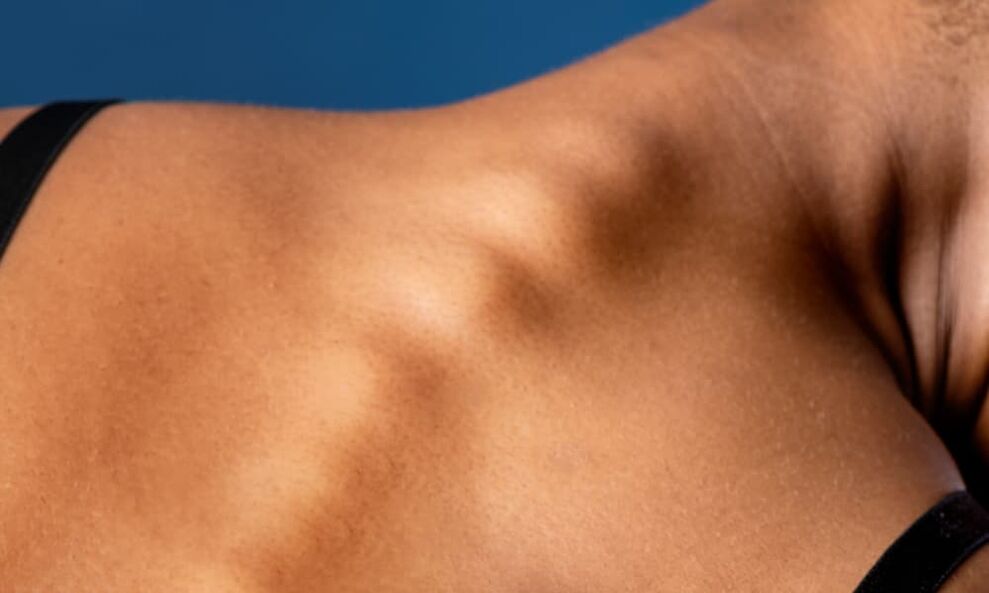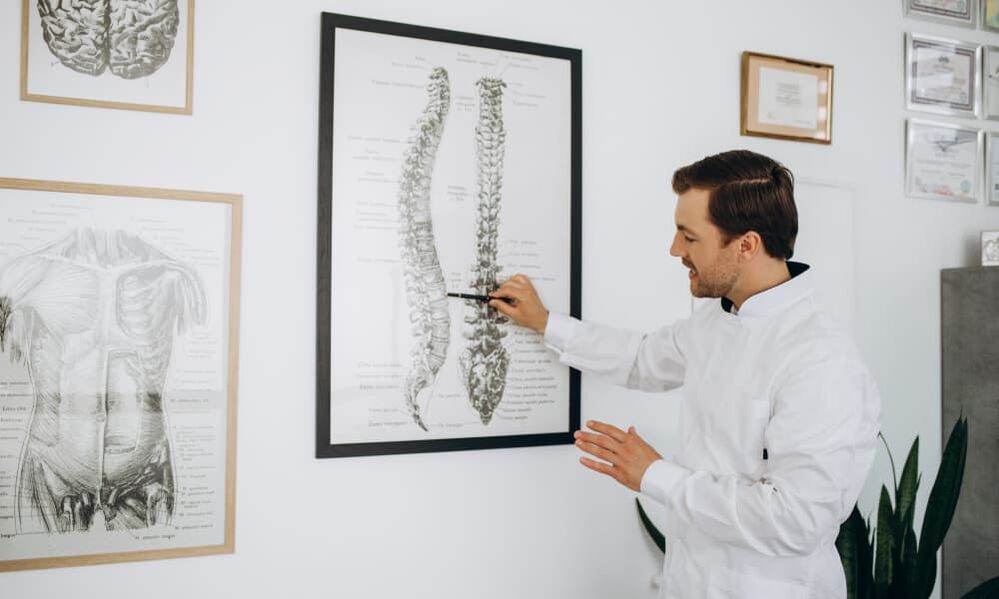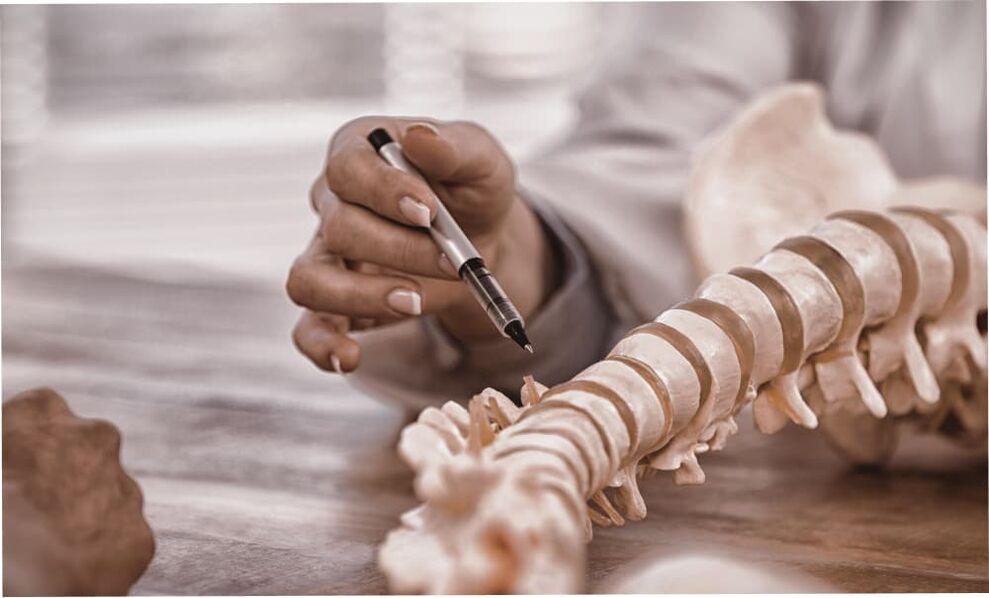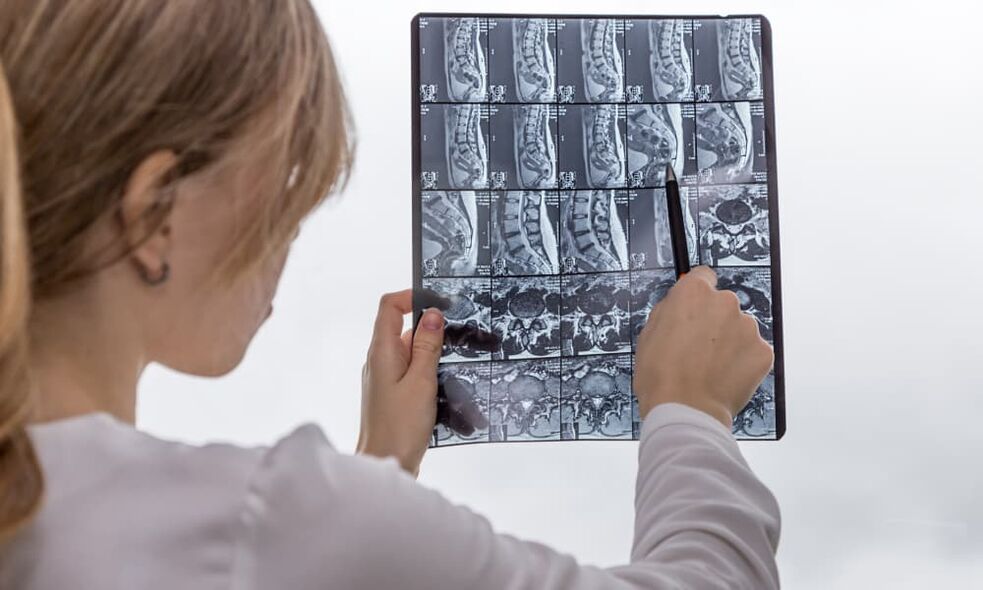
Osteochondrosis– is a degenerative-dystrophic disease, which is manifested by a decrease in the height of the hyaline intervertebral cartilage. Ultimately, this leads to disk wear and loss of functionality.
The disease is most often diagnosed in people aged 30-35, and it affects about 40% of the population under 35-40 and almost 90% in the elderly. However, in the presence of unfavorable factors, it can appear earlier.
Osteochondrosis of the spine is one of the main causes of back pain. Insufficient treatment can lead to nerve root damage, spinal cord damage and internal organ disorders. Therefore, it is very important to seek medical help as soon as possible and take appropriate measures to prevent the development of the disease.
Causes of osteochondrosis

Osteochondrosis is a common disease that can occur in older people, but it can also occur in young people who are used to a sedentary lifestyle. This disease occurs due to the weakening of the back muscles, which leads to disruption of blood flow and nutrition of the tissues of the spine and intervertebral discs. It can occur for a variety of reasons, including aging, injury, sudden stress, and improper work habits.
Although the causes of osteochondrosis are not fully understood, they are associated with a variety of factors, including:
- heredity,
- improper physical development,
- metabolic disease,
- unhealthy diet
- lack of vitamins and minerals,
- long-term use of drugs,
- overweight,
- increased load on the spine,
- a sedentary lifestyle, for example, when you work in an office,
- spinal injuries,
- past infectious diseases and stress.
In addition, malformations of the nervous and musculoskeletal system can contribute to the development of osteochondrosis. In general, the development of this disease is caused by a combination of many factors, and its prevention consists of proper nutrition, moderate physical activity, proper distribution of load on the spine, as well as maintaining a healthy lifestyle in general.
Symptoms and signs of osteochondrosis
With the development of osteochondrosis, in the first stages, patients often have the following problems:
- Pain in different parts of the body, such as the back, neck or other areas;
- Difficulty in movement and limitations in turning or bending;
- Constant tension and muscle spasms;
- Migraines and dizziness;
- Painful sensations in the area of the heart;
- Muscular hypotension, reduced muscle tone and strength;
- Numbness of limbs;
- Pain in arms and legs;
- Spots before the eyes;
- Cooling of extremities;
- Recording painful sensations.
If osteochondrosis is advanced, serious complications may occur such as:
- Loss of consciousness;
- Decreased sensitivity of limbs;
- Poor blood circulation in blood vessels;
- Nerve damage or inflammation;
- Narrowing and clogging of the arteries.
You should pay attention to any changes in your body condition and seek help from a specialist if you suspect the development of osteochondrosis. Seeking help early can prevent serious complications and improve quality of life.
Risk factors
Osteochondrosis can occur as a result of injury or heavy physical activity, which is especially common in athletes. It also manifests itself in the form of bone growth, osteophytes, bulging intervertebral discs and curvature of the spine. Congenital defects of the spine can also cause rapid wear of the intervertebral discs. In addition, the following risk factors can lead to the development of osteochondrosis:
- Neuro-emotional exhaustion;
- Physical overexertion of the body;
- Work on vibrating platforms;
- Genetic predisposition;
- Lack of vitamins in the body;
- Multiple pregnancy.
Understanding these risk factors can help you prevent the possibility of developing osteochondrosis. Managing your health through a healthy lifestyle and diet, as well as avoiding injuries and overexertion, can reduce the likelihood of this problem occurring. If you suspect osteochondrosis, consult a doctor to start treatment quickly and prevent possible complications.
Classification and stages of development of osteochondrosis
Classification of osteochondrosis
There are different forms of osteochondrosis, which can manifest as pain in different parts of the spine.
- Lumbodynia– this is pain in the lumbar (lumbosacral) back.
- Sciaticait is manifested by back pain that spreads to the legs.
- Lumbago- this is lumbar lumbago, with acute and severe pain in the lower back.
- Thoracalgia- This is chest pain.
Another form of osteochondrosis, cervicalgia or cervicobrachialgia, causes pain in the neck and upper limbs.
In addition, the types of osteochondrosis can vary depending on which part of the spine is affected. Osteochondrosis of the cervical spine is manifested by headaches and difficulty turning the head, osteochondrosis of the thoracic spine causes pain in the thoracic spine, and osteochondrosis of the lumbar spine can manifest as difficulty bending and pain that can sometimes "shoot" in the leg.
Stages of development of osteochondrosis
Osteochondrosis is one of the most common diseases of the spine. Its development goes through several stages.
- I.In the first stage, the core of the intervertebral disc loses moisture and becomes less elastic, which leads to a decrease in height and rupture of the tissue. At this stage, the pain is usually almost imperceptible, but discomfort may occur during physical activity or unusual posture.
- II.In the second stage of the development of osteochondrosis, the disc tissue begins to flatten and bulge, which leads to narrowing of the space between the vertebrae and pinching of the spinal nerve roots. The fibrous membrane is destroyed, which leads to poor fluid retention in the disc core. When moving, you can hear the characteristic clicking and creaking in the spine. At this stage, point pain appears, which is intensified by active movements.
- III.The third stage is characterized by abrasion and thinning of the cartilage lining between the discs. At this stage, the symptoms of osteochondrosis are intensely manifested in the form of acute pain. To quickly relieve the pain, you need to take painkillers for neuralgia.
- IV.In the last, fourth stage, the destruction of the discs is so severe that the joints become inactive, and the space between the vertebrae is overgrown with bone tissue. Severe dystrophic processes can cause acute pain, as growths injure neighboring tissues and compress nerves. Complete loss of vertebral mobility is possible.
Complications
Let's consider various complications that can arise with osteochondrosis:
- Disc protrusion, which occurs when the nucleus pulposus of the disc protrudes beyond the annulus fibrosus. This can lead to pain and dysfunction of the spine.
- Intervertebral hernia- This is an even more serious complication when the disc-ring ruptures and the nucleus pulposus expands beyond it. This can cause severe pain, reduced sensation and paralysis.
- Radiculitis- It is a pinched nerve root, which is accompanied by severe pain symptoms. Radiculitis can lead to loss of sensation, numbness and weakness in the lower extremities.
- Kyphosisis a spinal deformity that manifests itself as a bulge in the chest area. This can lead to breathing problems, pain and poor posture.
- Spinal cord stroke- this is the most severe complication of osteochondrosis, which can lead to loss of sensitivity, damage to motor functions, and even paralysis.
- Atrophy of the muscles of the lower extremities- this is a decrease in muscle mass, which is accompanied by rapid fatigue and weakness in the legs.
- Paralysis of the legs- this is a complete loss of the ability to make voluntary movements of the lower limbs, which is a serious complication of osteochondrosis.
Methods of diagnosing osteochondrosis

Osteochondrosis is a pathology characterized by a degenerative process in the structures of the spine. Based on clinical studies, we can learn more about how to treat this pathology.
If osteochondrosis is suspected, the doctor conducts a comprehensive diagnosis, including the following methods:
- Overview.The doctor examines the patient and assesses his general condition, posture and movements. The doctor may also perform a neurological test to determine the presence or absence of sensory and motor problems.
- Hardware overview.For a more accurate diagnosis, various hardware examination methods are used, including radiography, computed tomography (CT) and magnetic resonance imaging (MRI).
- Blood tests.A complete blood count can help identify early signs of osteochondrosis, such as an increased red blood cell sedimentation rate and low calcium levels. To confirm the diagnosis, biochemical tests can be prescribed that evaluate coagulation parameters, enzyme activity, the content of zinc, cobalt, iron and other components.
- Radiography.During the X-ray, each spine is checked and images are taken in direct, lateral and two oblique projections. If necessary, a functional radiograph can be prescribed, which allows you to assess the condition of the spine in different positions.
- Computed tomography (CT).CT is performed after radiography and allows you to more accurately determine the condition of the intervertebral discs. To do this, images of one or two segments of the spine are taken.
- Magnetic resonance imaging (MRI).MRI is used along with CT or in cases where it is necessary to study the condition of blood vessels, nerve processes and intervertebral discs in more detail.
When to see a doctor
Consultation with a doctor is necessary in case of persistent back pain, muscle spasms and reduced sensitivity.
Treatment of osteochondrosis

Osteochondrosis is a disease of the spine characterized by degenerative changes in the intervertebral discs. It can lead to back pain, neck pain, headaches and other unpleasant symptoms. Treatment of osteochondrosis can be a long and labor-intensive process, but modern methods can help relieve pain and improve quality of life. It can be conservative or surgical, depending on the degree of progression and severity of symptoms. In most cases, it is recommended to strengthen the ligaments and muscles, as well as the use of medication.
When treating osteochondrosis, it is important to take into account the individual characteristics of each patient. Some methods of massage or manual therapy may be undesirable or even dangerous for a particular case. Therefore, it is important to have an individual consultation before starting treatment.
Procedures and methods of treatment of osteochondrosis include physiotherapy, gymnastics (physical therapy), wearing an orthopedic pillow or corset, as well as taking muscle relaxants and non-steroidal analgesics.
Movement therapy
Leading countries with a good level of medicine prefer to use movement therapy. These are classical physical therapy, physiotherapy exercises in water, swimming, simulator training and computer hardware complexes. Styles are chosen by the doctor and may vary depending on the individual characteristics of each patient. Swimming can also be beneficial, but requires proper technique to avoid harm to your health.
Treatment of osteochondrosis with manual therapy
Manual therapy can be used in the initial stages. This method helps to strengthen the muscle frame and remove blockages and pinched nerve roots. However, if the shape of the vertebrae changes and bone spurs form, this type of treatment is not recommended.
Manual therapy, done correctly, can improve the configuration of the spine. Sometimes permanent functional blockages can appear, that is, areas of stiffness in the spine and sacrum that cannot be removed by therapeutic exercises.
Modern manual therapy is different from what was used before. Most doctors no longer use the hard techniques that used to be accompanied by crunching, but prefer soft techniques. They are based on knowledge of biomechanics, joint function and the laws of muscle contraction and relaxation. The risk of side effects with these methods is lower, and the effectiveness has not changed.
Massage
Massage has many contraindications, so the neurologist must prescribe an individual course of treatment. It is important to choose a competent massage therapist with whom the doctor works. Massage should be performed regularly, usually the doctor prescribes at least 2-3 sessions per week for 1-3 months.
Correctly performed medical massage for osteochondrosis of the spine:
- Provides additional stress to muscles and increases their tone;
- Removes lactic acid accumulation and relieves muscle spasms;
- Improves blood circulation in the affected area and adjacent tissues;
- It relieves pain.
Only medical massage is suitable for the treatment of osteochondrosis, while Thai massage is dangerous. Most Thai massage therapists use harsh manual therapy techniques and do not pay attention to the physical condition of the patient.
Physiotherapy
Depending on the location and stage, patients may be prescribed the following types of physiotherapy:
- Magnetotherapyis the effect of a constant frequency magnetic field that stimulates a cellular response.
- Electrophoresis for osteochondrosis- it is the action of the electric field on the tissue, which accelerates blood circulation and activates regeneration processes.
- Laser therapyis a method that stimulates biological processes in nerve fibers, and has anti-inflammatory, wound healing and analgesic effects.
- Shock wave therapyis a method of influencing the diseased area of the body with acoustic waves, which improves microcirculation and metabolic processes, relieves swelling and pain.
All these methods can be prescribed by a doctor according to the individual needs of the patient and the stage of the disease.
Kinesio taping
Kinesio taping is a safe method that is actively used in sports medicine and is widespread in South Korea.
Kinesio tape is a cotton patch with a soluble adhesive that can be used to treat neck, chest, back and joint pain. There are special types of therapeutic applications that can be used at home, but when recording yourself, you must be careful, because complications are possible.
When performing kinesio taping, restrictions should be taken into account: for women, these are pregnancy and menstruation. Some patients may have an allergic reaction to the patch.
Acupuncture
Acupuncture is a method in which a doctor inserts special needles into certain parts of the body. This leads to acceleration of blood circulation, lymph circulation and metabolic processes, improving the condition of the spine and the whole body. Acupuncture can be used for osteochondrosis in the initial stages, as well as for intense pain and poor mobility of the vertebrae.
There is also a dry needling technique where an unmedicated needle is inserted into the muscle that is spasming, usually the piriformis. This method can reduce back and pelvic pain. It is worth noting that acupuncture is effective even in chronic cases.
Hirudotherapy
Hirudotherapy is a method in which medical leeches are used to treat various diseases, including osteochondrosis. Hirudotherapy prevents increased blood clotting and the formation of blood clots, dilates blood vessels, removes inflammatory processes and has an analgesic effect. For osteochondrosis, leeches are used to improve the blood supply to cells, which in turn promotes the restoration of damaged intervertebral discs.
Drug treatment
Currently, there is a tendency to reduce the use of drugs in the treatment of osteochondrosis. This is because some drugs can have serious side effects and negatively affect the patient's health.
Pain in osteochondrosis often occurs against the background of minor changes in the spine, and if the doctor chooses the right treatment without drugs, the patient can avoid repeated pain attacks. If you take the medicine for a long time, the structural changes in the spine can worsen and the pills will no longer work. In addition, drug therapy may be contraindicated in some cases.
One of the alternatives to drug treatment is kinesio taping. This is a method in which special elastic plasters are glued to the diseased areas of the body. Kinesi taping is safer and more effective than drug therapy and can be used as a pain reliever.
Reflexology
Reflexology is a method based on proper influence on painful points and reflex zones. It is used to relieve pain and restore the natural load on the spine. Reflexology is never used alone, but is usually used in combination with massage to achieve a more significant effect.
The technique of reflexology can be used to treat osteochondrosis and other diseases of the spine. Its use helps to relieve pain and restore the natural load on the spine. In addition, reflexology can be used to improve the general condition of the body and to prevent diseases.
Prevention and prognosis of osteochondrosis

Prevention of osteochondrosis is an extremely important issue, because it is aimed at preventing factors that can contribute to the onset of this disease. First of all, this applies to people who have certain risks:
- Genetic predisposition to spine diseases;
- Chronic gastrointestinal problems that can lead to malabsorption of nutrients;
- Diseases associated with metabolic disorders;
- Severe infections acquired in childhood, such as rickets;
- Spinal injuries;
- Excessive weight.
However, prevention is also important for people who lead a sedentary lifestyle, have increased stress on the spine and for women who are planning pregnancy. For the purpose of prevention, it is recommended to exercise regularly, monitor body weight, avoid injuries and eat a healthy diet rich in vitamins and minerals. Consultation with a doctor and regular medical examinations are also recommended in order to detect the disease at an early stage.
Diet for osteochondrosis
One of the important aspects of treating osteochondrosis is proper nutrition. The body must receive the necessary amount of substances for the synthesis of cartilage tissue, so a balanced diet is recommended.
It is important to eat fresh fruits and vegetables, protein foods, as well as dishes containing mucopolysaccharides - such as fruit jellies, jellies or jelly fish. However, you should avoid fatty, fried and salty foods, and limit your intake of sugar and alcohol, as they can contribute to inflammation.
It is recommended to drink more fluids to ensure proper hydration and maintain the health of the intervertebral discs. It is also recommended to consult with a doctor or nutritionist to create an individual diet that takes into account the characteristics of the disease and the individual needs of the patient.
Exercises for osteochondrosis
Exercises for the treatment of osteochondrosis of the spine are prescribed by a doctor if there is pain. The set of exercises is selected individually, taking into account the form, degree and stage of the disease. For example, in the initial stage of cervical osteochondrosis, it is recommended:
- perform head tilts;
- turn your head right and left;
- draw numbers from 0 to 9 in the air with your chin;
- move your chin back and forth in a horizontal plane.






















